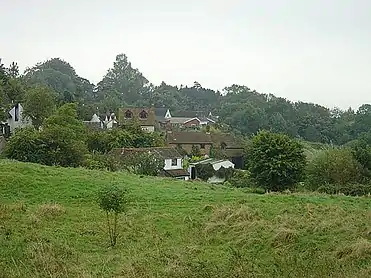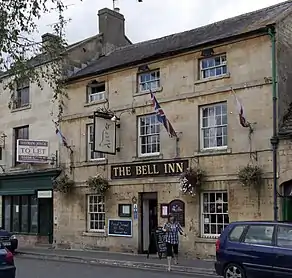Bree (Tolkien)
Bree is a fictional village, with the land around it, in J. R. R. Tolkien's Middle-earth, east of the Shire, and the only place where Hobbits and Men lived side by side. It was inspired by the Buckinghamshire village of Brill, which Tolkien visited regularly in his early years at Oxford,[T 1][1] and informed by his passion for linguistics.[2]
| Bree | |
|---|---|
| J. R. R. Tolkien's legendarium location | |
| In-universe information | |
| Type | Group of Cross-road Hamlets Group of villages |
| Ruler | Kings of Arnor later Arthedain later Reunited Kingdom |
| Locations | The Prancing Pony, Bree-hill |
| Geography | Bree-land, in central Eriador |
| Founder | Men of Twilight |
In Bree was The Prancing Pony inn, where the wizard Gandalf met the Dwarf Thorin Oakenshield, setting off the quest to Erebor described in The Hobbit, and where Frodo Baggins put on the One Ring, attracting the attention of the Dark Lord Sauron's spies and an attack by the Black Riders.
Etymology

The name Bree means "hill" according to Tolkien, justifying the name by arranging the village and the surrounding Bree-land around a large hill, named Bree-hill. The name of the village Brill, in Buckinghamshire, which inspired Tolkien to create Bree,[T 1] has the same meaning: Brill is a modern contraction of Breʒ-hyll. Both syllables are words for "hill" – the first is Celtic and the second Old English.[2]
Description
In Tolkien's fiction, Bree was an ancient settlement of men in Eriador, long established by the time of the Third Age of Middle-earth. After the collapse of the kingdom of Arthedain, Bree continued to thrive without any central authority or government for many centuries. As Bree lies at the meeting of two large roadways, the Great East Road and the (now disused) Greenway, it had for centuries been a centre of trade and a stopping place for travellers, though as Arnor in the north waned Bree's prosperity and size declined.
Tolkien wrote of two different origins for the people of Bree. One was that Bree had been founded and populated by men of the Edain who did not reach Beleriand in the First Age, remaining east of the mountains in Eriador. The other was that they were stemming instead from the same stock as the Dunlendings.[T 2][T 3]
By the time of The Lord of the Rings, Bree was the westernmost settlement of men in Middle-earth, and there was no other settlement of men within a hundred leagues of the Shire.[T 2] A day's ride east along the road lay The Forsaken Inn, according to Aragorn, although nothing more is known of it. Directly west of Bree were the Barrow-downs and the Old Forest. Bree was the chief village of Bree-land, the only place in Middle-earth where men and hobbits dwelt side by side. The hobbit community was older than that of the Shire, which was originally colonized from Bree. There were four villages in Bree-land:
- Bree was the largest settlement. Bree had a gate and gatekeepers to keep out troublemakers from the wild lands beyond.
- Staddle was populated primarily by hobbits who made a living from light agriculture, including pipe-weed. Staddle was on the south-eastern side of Bree-hill, sitting south of Combe and Archet. It was the only village (other than Bree itself) visible from the Great East Road.
- Combe was populated primarily by men, with some hobbits, all of whom made a living from agriculture. Combe was situated on the borders of the Chetwood and on the edge of Bree-hill, between the villages of Archet and Staddle.
- Archet was the furthest north. It was in the Chetwood, and populated primarily by men.
The Prancing Pony

The Prancing Pony was an inn in Bree. It served locals, and was familiar to travellers, as one of Eriador's major cross-roads was just outside the village: the meeting of the Great East Road and the Greenway. The inn was in the centre of the village at the base of the Bree-hill, at the spot where the East Road made a bend. The building is described in The Lord of the Rings:
"Even from the outside the inn looked a pleasant house to familiar eyes. It had a front on the Road, and two wings running back on land partly cut out of the lower slopes of the hill, so that at the rear the second-floor windows were level with the ground. There was a wide arch leading to a courtyard between the two wings, and on the left under the arch there was a large doorway reached by a few broad steps. ... Above the arch there was a lamp, and beneath it swung a large signboard: a fat white pony reared up on its hind legs. Over the door was painted in white letters: THE PRANCING PONY by BARLIMAN BUTTERBUR."[T 2]
Inside was a large common room, several private parlours, and a number of bedrooms, including a few rooms in the north wing designed for Hobbits, that were low to the ground and had round windows. The inn is also described as having stables.
The Prancing Pony was frequented by Men, Hobbits and Dwarves. Bucklanders from the Shire occasionally travelled to the inn. The art of smoking pipe-weed was said to have begun in Bree, and from The Prancing Pony it spread among the races of Middle-earth. The inn was noted for its fine beer, once sampled by Gandalf.[T 4] Tom Bombadil knew the inn, but presumably only by repute as he never left his own little realm.
Barliman Butterbur
Butterbur was a fat, bald Man with a bad memory. His family had kept the inn "from time beyond record".[T 5] Two of his employees are mentioned: Nob, a hobbit servant, and Bob, who worked in the stables and whose race is not specified.[T 2]
After his inn was attacked by the black riders during the adventure for the destruction of the One Ring, Barliman offered the Hobbits (Merry, Pippin, Frodo and Sam), whose ponies were stolen during the raid, to buy them new rides, they agreed but it later turned out there were no ponies available within the town except one "poor old half-starved creature" that they bought from Bill Ferny for "twelve silver pennies", described as "more than thrice its worth".[T 2]
As with other Men of Bree, Butterbur's surname is taken from a plant—the herbaceous perennial Petasites hybridus. Tolkien described the butterbur as "a fleshy plant with a heavy flower-head on a thick stalk, and very large leaves." He evidently chose this name as appropriate to a fat man; he suggested that translators use the name of some plant with "butter" in the name if possible, but in any event "a fat thick plant".[T 6][4]
History
Two important events leading up to the War of the Ring took place at The Prancing Pony. The first was "a chance-meeting" of Gandalf and Thorin Oakenshield; this meeting eventually led to the destruction of Smaug and far lighter casualties during the war in the northern theatre.[T 7]
The second occurred during the journey of Frodo Baggins to Rivendell, when he and his companions stayed at The Prancing Pony for a night. After singing The Man in the Moon Stayed Up Too Late, Frodo accidentally put the One Ring on and became invisible. The minor villain Bill Ferny and a squint-eyed Southerner saw him vanish, and informed the Black Riders, who attacked the inn. Aragorn saved him and led the party away, after Butterbur delivered a letter from Gandalf which he had forgotten to deliver months earlier.[T 2][T 8]
Business at The Prancing Pony declined during the war because of an influx of rough Men from the South who terrorized Bree and the surrounding countryside. However, when Gandalf stopped with the Hobbits at the inn on their way home, he prophesied that "better days" were coming as the Kingdom was restored and "some fair folk" would be staying at The Prancing Pony.[T 9]
In adaptations
In Peter Jackson's The Fellowship of the Ring, far from being a friendly place as in the book, Bree is constantly unpleasant and threatening; and whereas in the book the Ring just makes Frodo disappear when he puts it on in The Prancing Pony, in the film there are special effects with a strong wind, blue light, and the Eye of Sauron.[5] Butterbur appears in both Ralph Bakshi's animated 1978 adaptation of The Lord of the Rings and Peter Jackson's film, but in both adaptations most of his scenes are cut. Alan Tilvern voiced Butterbur (credited as "Innkeeper") in the animated film,[6] while David Weatherley played him in Jackson's epic.[7] A character credited as "Butterbur, Sr" appears briefly during the prologue of Jackson's The Hobbit: The Desolation of Smaug, portrayed by Richard Whiteside.[8] James Grout played Butterbur in BBC Radio's 1981 serialization of The Lord of the Rings.[9] In the 1991 low-budget Russian adaptation of The Fellowship of the Ring, Khraniteli, he appears as "Lavr Narkiss", played by Nikolay Burov.[10] In the 1993 television miniseries Hobitit by Finnish broadcaster Yle, Butterbur ("Viljami Voivalvatti" in Finnish, meaning "William Butter") was portrayed by Mikko Kivinen.[11] Bree and Bree-land are featured prominently in the PC game The Lord of the Rings Online, which allows the player to explore the town.[12]
References
Primary
- This list identifies each item's location in Tolkien's writings.
- Tolkien 1988, ch. 7, p. 131, note 6. "Bree ... [was] based on Brill ... a place which he knew well".
- Tolkien 1954a, book 1, ch. 9 "At the Sign of the Prancing Pony"
- Tolkien 1955, Appendix F
- Tolkien 1954a, book 2, ch. 2 "The Council of Elrond"
- Tolkien 1954a, Prologue: "Concerning Pipe-weed"
- Tolkien, J. R. R. (1975). Lobdell, Jared (ed.). Guide to the Names in The Lord of the Rings. A Tolkien Compass. Open Court. p. 162. ISBN 978-0875483030.
- Tolkien 1980, "The Quest of Erebor"
- Tolkien 1980, "The Hunt for the Ring"
- Tolkien 1955, book 6, ch. 7 "Homeward Bound"
Secondary
- Tom Shippey, Tolkien and Iceland: The Philology of Envy Archived 2007-10-14 at the Wayback Machine
- Mills, A. D. (1993). Brill. A Dictionary of English Place-Names. Oxford University Press. p. 52. ISBN 0192831313.
- ""The Prancing Pony by Barliman Butterbur"" (PDF). ADCBooks. Archived from the original (PDF) on 13 April 2013. Retrieved 26 September 2014.
- Judd, Walter S.; Judd, Graham A. (2017). Flora of Middle-Earth: Plants of J. R. R. Tolkien's Legendarium. Oxford University Press. pp. 342–344. ISBN 978-0-19-027631-7.
- Croft, Janet Brennan (2005). "Mithril Coats and Tin Ears: 'Anticipation' and 'Flattening' in Peter Jackson's The Lord of the Rings Films". In Croft, Janet Brennan (ed.). Tolkien on Film: Essays on Peter Jackson's The Lord of the Rings. Mythopoeic Press. p. 68. ISBN 1-887726-09-8.
- "Innkeeper". Behind the Voice Actors. Retrieved 25 September 2020.
- "David Weatherley". RBA Management. Retrieved 25 September 2020.
- "Richard Whiteside". NZonScreen. Retrieved 25 September 2020.
- "Inspector Morse actor James Grout dies at 84". BBC News. 5 July 2012. Retrieved 25 September 2020.
- "[Khraniteli] The Fellowship of the Ring (1991-): Full Cast & Crew". IMDb. Retrieved 7 April 2021.
- "Barliman Butterbur". WhatCharacter. Retrieved 25 September 2020.
- Porter, Jason (22 May 2007). "Lord of the Rings Online: Shadows of Angmar". GameChronicles. Retrieved 25 September 2020.
Sources
- Tolkien, J. R. R. (1954a), The Fellowship of the Ring, The Lord of the Rings, Boston: Houghton Mifflin, OCLC 9552942
- Tolkien, J. R. R. (1955), The Return of the King, The Lord of the Rings, Boston: Houghton Mifflin, OCLC 519647821
- Tolkien, J. R. R. (1980), Christopher Tolkien (ed.), Unfinished Tales, Boston: Houghton Mifflin, ISBN 978-0-395-29917-3
- Tolkien, J. R. R. (1988), Christopher Tolkien (ed.), The Return of the Shadow, Boston: Houghton Mifflin, ISBN 978-0-395-49863-7
.jpg.webp)